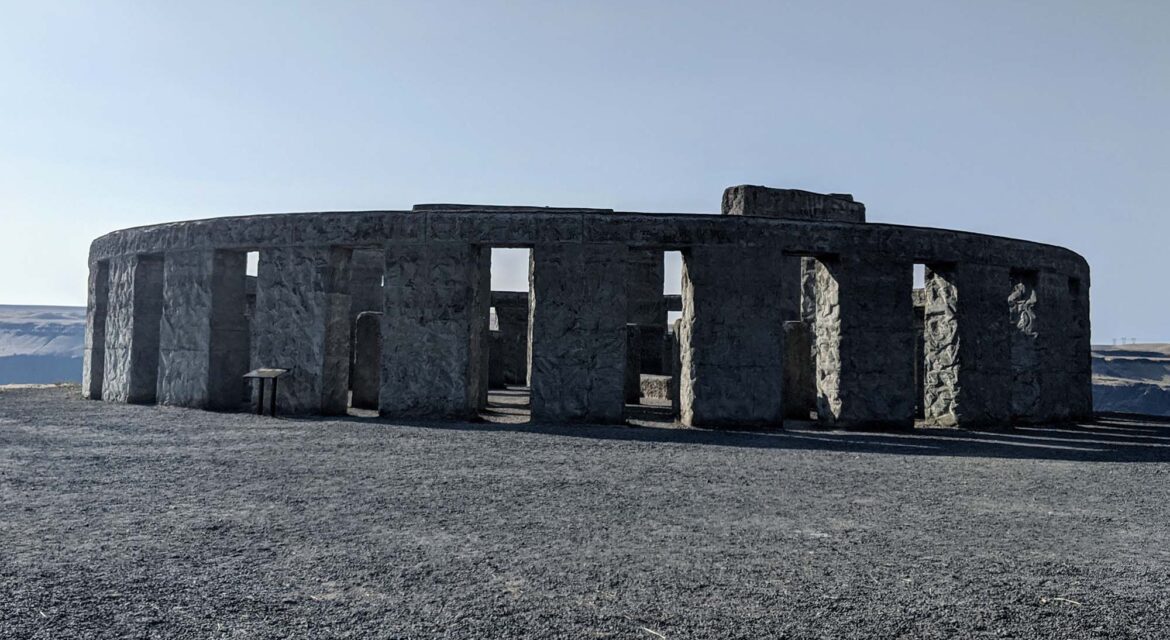 Designed as a monument to the valor and heroism of World War I, the Stonehenge Memorial in Maryhill, Washington, is equal parts memorial and attraction. Better known as the Maryhill Stonehenge, the monument highlights what it can look like when stakeholders take a creative approach to memorializing people, events and concepts.
Designed as a monument to the valor and heroism of World War I, the Stonehenge Memorial in Maryhill, Washington, is equal parts memorial and attraction. Better known as the Maryhill Stonehenge, the monument highlights what it can look like when stakeholders take a creative approach to memorializing people, events and concepts.

Created as a World War I Memorial
 Said to be the first monument that was created specifically to celebrate the people and sacrifices of veterans who fought for the United States in World War I, the Maryhill Stone was created by entrepreneur Sam Hill. The design of the Maryhill Stonehenge duplicates in size and original from England’s famous Stonehenge, which Hill believed had been created and used for human sacrifices. Since Stonehenge is thousands of years old, Hill was inspired to create a monument that would serve as a memorial to and reminder of the tragedy of the continual loss of human life at the hands of one another.
Said to be the first monument that was created specifically to celebrate the people and sacrifices of veterans who fought for the United States in World War I, the Maryhill Stone was created by entrepreneur Sam Hill. The design of the Maryhill Stonehenge duplicates in size and original from England’s famous Stonehenge, which Hill believed had been created and used for human sacrifices. Since Stonehenge is thousands of years old, Hill was inspired to create a monument that would serve as a memorial to and reminder of the tragedy of the continual loss of human life at the hands of one another.
A marker located in the center of the monument mentions that the site is dedicated to the memory of the soldiers and sailors of Klickitat County who gave their lives in defense of their country. It also mentions that it was erected in the hope that others would be inspired by the example of their valor and heroism so that those viewers might share in the love of liberty and patriotism.
The altar stone of the Maryhill Stonehenge was dedicated in 1918, while the full structure was completed and dedicated in 1929. Since then it has become part of the Maryhill Museum of Art that has further attracted visitors from across the region to experience the monument as well as the people it commemorates.

Engaging with a Monument
Constructed of concrete, the Maryhill Stonehenge is engineered like a modern road. Uniform blocks of concrete have been poured to mimic the layout and placement of the original structure. This has defined the ways that visitors can engage with the monument. Various markers provide additional context and information about the people and events being memorialized.
 Designed to duplicate the original size and design of the ancient Neolithic ruin in England, the altar stone of the Maryhill Stonehenge is placed to align with the sunrise on the Summer Solstice. Visitors can engage with the monument and stones in a way that is impossible at the prehistoric monument in England.
Designed to duplicate the original size and design of the ancient Neolithic ruin in England, the altar stone of the Maryhill Stonehenge is placed to align with the sunrise on the Summer Solstice. Visitors can engage with the monument and stones in a way that is impossible at the prehistoric monument in England.
Standing three miles east of Maryhill Museum of Art, the monument has created numerous opportunities for the organization. Each year, a small memorial ceremony is held on the anniversary of the death of the 14 men honored at Stonehenge Memorial. The public is invited to these events, providing a sense of connection to the community that attracts attention from across the region.
In 1995, the Klickitat County Veterans’ Memorial was erected near the Maryhill Stonehenge to honor those who have died in service of their country since WWI. A partnership between Maryhill Museum of Art and the Klickitat County Veterans Association, the memorial highlights what it can look like for monuments to enable further growth and expansion once they have been established.
Picnic grounds and the neighboring Maryhill Winery are just a few of the other attractions in the vicinity of the Maryhill Stonehenge, further showcasing why it has become a popular stop for residents and visitors. This popularity is the result of an imaginative approach to creating a memorial that is about much more than a single conflict or individual sacrifice.

More Than a Memorial

By honoring the sacrifices that were made during World War I on a spot that provides incredible views of the region, the Maryhill Stonehenge has been able to become more than a memorial. It has imagined and realized what it could look like to provide audiences of all eras with numerous reasons to visit the site for the benefit of everyone. Free to visit throughout the year, the Maryhill Stonehenge allows audiences to easily experience the beauty of the surrounding area as well as the cultural significance of a monument that resides on the other side of the planet.

